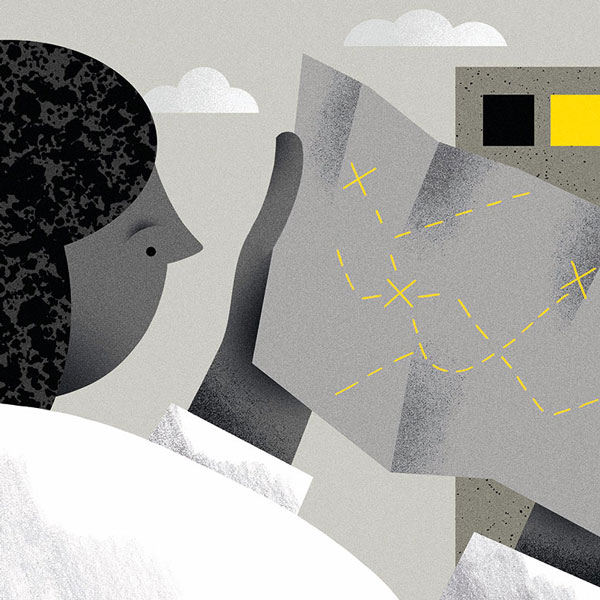Feature: Issue 126
Lena Gubler: “The fact that such high subsidies have a negative impact should be a wake-up call”.
Every year, Switzerland pays out billions of francs in subsidies for road construction, agriculture, hydroelectric power, tourism and many other sectors. But these monies can be fatal for biodiversity, as shown by a large-scale study carried out by the Swiss Federal Institute for Forest, Snow and Landscape (WSL).

Lena Gubler is a geographer at the Swiss Federal Institute for Forest, Snow and Landscape (WSL) | Image: Gabi Vogt
Lena Gubler, your study on misplaced financial incentives sounds like a huge undertaking. How did you and your team set about it?
First we assessed the state of biodiversity in the range of habitats. We investigated why a specific habitat might be disturbed, polluted or fragmented. This led us to the causes or drivers of these disturbances. Then we looked at which of these driving forces are subsidised in some way by the state. To this end we analysed documents, examined annual financial statements, enquired at federal authorities, and spoke to experts. We also called on communities of professionals to notify us of subsidies in their own region.
What did you find out?
A total of at least CHF 40 billion per annum is paid out in subsidies that have a complete or partially negative impact on biodiversity. That’s 30 to 40 times more than is paid out to protect it. What’s more, it transpired that the impact on biodiversity exerted by these negative drivers is highly complex.
Complex? How?
There are large-scale conflicts of interest with many subsidies; some are in conflict with other political goals, while others result in trade-offs between different environmental concerns. Sometimes, a subsidy is intended to promote environmental protection, but at the same time the side-effects damage biodiversity. One example is small-scale hydropower, which is being heavily subsidised because of the current energy strategy. If hydropower can replace fossil fuels, it’s good for the climate and thus good for biodiversity. But the high degree of investment there means that just about every mountain stream is now being shored up and divided into different segments. That means fish can no longer swim either upstream or down, and hence are hardly able to reproduce.
People have long been insisting that such damaging subsidies should be cancelled. So why has the federal government done nothing up to now?
When it ratified the Convention on Biodiversity, Switzerland committed itself to abolishing or redirecting harmful subsidies by the year 2020. But there has yet to be any study of such subsidies that is as comprehensive as ours, which now provides a basis for their abolition. What’s more, some of them have been around for such a long time that the current subsidised state of affairs is regarded as the norm, even as right and fitting. One such example is the mineral oil tax. It has not been adjusted for inflation since the 1990s. Why? Because the population expects transport to be cheap, and thus petrol too.
Can we really call this a subsidy? After all, road transport covers its expenditure with the income from traffic duties.
To be more precise, we speak here of financial disincentives. The strict earmarking of traffic duties in Switzerland is an extraordinary thing. Taxes such as the mineral oil tax or the national road tax (also called the ‘highway permit sticker’) flow primarily into the national road fund, which in principle means more roads can be built. But if the income were to flow simply into the federal treasury, other federal tasks could be financed with it. Or there could be a stipulation that earmarked funds should increasingly be used to reduce the negative impact of road traffic – such as by providing more covered sections of road where they are deemed necessary.
As for agriculture, isn’t food production a matter of overriding public interest that has to be assigned greater priority than biodiversity, whether we like it or not?
In the medium term, agricultural production – and thus the reliability of our food supply – depends on biodiversity. If we can’t stop the loss of biodiversity, we will lose soil fertility, pollination and clean drinking water. And then crop yields will begin to dwindle.
What agricultural subsidies are particularly harmful?
Subsidies that incentivise keeping large numbers of animals are the biggest problem. At present, animal numbers are too high, not least thanks to our high import volume of concentrated animal feed. This means that the Swiss ecosystems are overloaded with nitrogen, which in turn means large-scale damage to biodiversity.
What are the main recommendations of your study?
The realisation that such a high level of subsidisation has a negative impact on biodiversity should be a wake-up call. We should pay greater attention to plant and animal diversity in different sectors, and also in our political goals. We could avoid a lot of damage if subsidies were linked to specific conditions. In general, subsidies should also be time-limited. That way, we can prevent them from just becoming the new normal.
In what sector might it be easiest to achieve a change to current subsidy practices?
One thing that would be easy to change is the practice of unprofitable parking fees on public ground. Some of the many tax reduction options for residential property could also be scrapped easily, such as those for the underuse of residential property. Overall, quick progress could certainly be made if we started with tax reduction schemes.
- Sudden omnipresence
- A rock tomb for nuclear waste and CO<sub>2</sub>
- “Only demonstrating consensus gives a false impression of science”
- The power of images
- How the mask came upon us
- The impact of university PR on journalism
- No slowing down in the lab
- Susan Gasser, optimist emeritus
- Picture series: no more kisses, just namaste
- Bacteria in orbit
- Anna is Anna is Anna is Anna
- Love knows no boundaries
- Washing releases microplastics
- Is it right to accord dignity to animals?
- Safe transport with drones
- Restful roadsides
- Benzodiazepines: overuse in the elderly
- Estefania Cuero: “There is a great desire for solidarity”




